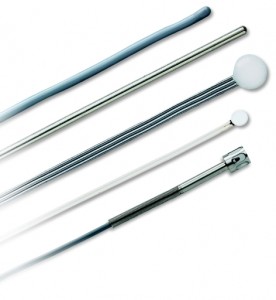
Thermistors for Medical Applications
Thermistors for Medical Applications have, for decades, and are still relative and reliable which this field demands. Thermistors sensitivity and interchangeability are the necessary charateristics required for monitoring patient temperature. Patient temperature is measured using thermistors that are packaged in variety of probes such as skin(surface) rectal, esophageal and catheter probes for subcutaneous applications.
NTC thermistors are also used for measuring flow in inserted devices. A pair of matched thermistors can be attached to the tip of a catheter which can be guided to different locations of the heart to measure blood flow. Either they can be heated by a coil of flushed with cold saline to measure blood flow rates. . When flushed with cold saline, the first sensor gets cooled more than the second because the blood flow warms up the saline that reaches the second sensor. . Since the two thermistor sensors are seperated by a known distance and the temperature and the volume of saline is controlled, the blood flow can be calculated by reading the outputs of the two sensors. When cold saline is used these thermistors do not require external power.
Catheter ablation sensors are another example of sensors temporarily inserted through incision to effect specific treatments and/or to take measurements during treatments. Ablation is the process of selectively killing tissue to create scar tissue in order to re-route nerve impulse flow within the heart to correct abnormal arythmias. RF energy is often used in the ablation process. It is critical that the force applied by the catheter tip to the target tissue not exceed predetermined values to avoid any possibility of perforating the target tissue.








